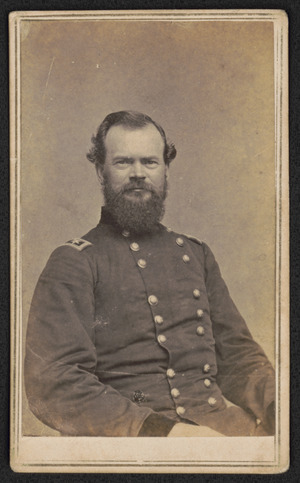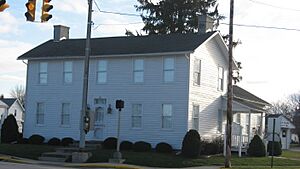James B. McPherson facts for kids
Quick facts for kids
James B. McPherson
|
|
|---|---|
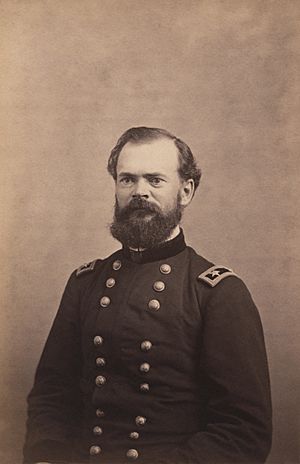
McPherson, c. 1862, by Barr & Young
|
|
| Born | November 14, 1828 Clyde, Ohio |
| Died | July 22, 1864 (aged 35) Atlanta, Georgia |
| Place of burial |
McPherson Cemetery, Clyde, Ohio
|
| Allegiance | United States Union |
| Service/ |
United States Army Union Army |
| Years of service | 1853–1864 |
| Rank | Major general |
| Unit | U.S. Army Corps of Engineers |
| Commands held | XVII Corps Army of the Tennessee |
| Battles/wars | |
| Signature | |
James Birdseye McPherson (born November 14, 1828 – died July 22, 1864) was a brave officer in the United States Army. He became a general for the Union Army during the American Civil War.
McPherson worked closely with important generals like Henry Halleck and Ulysses S. Grant. He fought alongside Grant at the Battle of Shiloh. Sadly, General McPherson was killed during the Battle of Atlanta. He was fighting against the army led by John Bell Hood, who was actually his old classmate from West Point. McPherson was the second-highest-ranking Union officer to die in battle during the war.
Contents
Early Life and Military Start
James McPherson was born in Clyde, Ohio. He went to Norwalk Academy before attending the United States Military Academy at West Point. He graduated first in his class in 1853.
His classmates included famous generals like Philip H. Sheridan and John Bell Hood. Hood would later become his enemy in the Civil War. After graduating, McPherson joined the United States Army Corps of Engineers. He even taught engineering at West Point for a year, which was unusual for such a young officer.
From 1854 to 1857, McPherson helped build defenses for New York harbor. He also worked on improving the Hudson River. Later, he oversaw the building of Fort Delaware. From 1857 to 1861, he was in charge of building defenses on Alcatraz Island near San Francisco, California. He was promoted to first lieutenant in 1858.
In San Francisco, he met Emily Hoffman from Baltimore. They became engaged and planned to marry. However, the start of the Civil War put their wedding on hold.
Serving in the Civil War
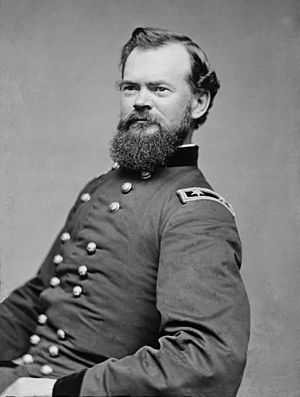
When the American Civil War began, McPherson asked to be transferred back east. He left California in August 1861 and arrived in New York soon after. He joined the staff of Major General Henry Halleck, a senior commander in the Western armies.
McPherson was promoted to captain in August. He was sent to St. Louis, Missouri, to serve under General Halleck. In November, Halleck made him an aide-de-camp and promoted him to lieutenant colonel.
Rising Through the Ranks
McPherson's career quickly advanced. He was a lieutenant colonel and Chief Engineer for Brigadier General Ulysses S. Grant. He helped Grant capture Fort Henry and Fort Donelson in February 1862.
Before the Battle of Shiloh, McPherson gathered important information. He learned that Confederate troops were moving by train to Corinth, Mississippi. This was a key railroad hub.
He was promoted to brigadier general on May 15, 1862. He then managed the railroads in western Tennessee. On October 8, he became a major general. Soon after, he took command of the XVII Corps in Grant's Army of the Tennessee.
In September 1862, McPherson joined General Grant's staff. He briefly led an infantry brigade. His promotions were largely due to the support of Halleck and Grant. After the Siege of Vicksburg, where McPherson commanded the center, Grant recommended him for another promotion. He became a brigadier general in the regular army in August 1863. After this, McPherson led troops into Mississippi and pushed back the enemy near Canton.
Atlanta Campaign
On March 12, 1864, McPherson was given command of the Army of the Tennessee. This happened after its previous commander, Major General William T. Sherman, was promoted. McPherson then asked for leave to go home and marry his fiancé, Emily Hoffman, in Baltimore, Maryland.
His leave was first approved but then canceled by Sherman. Sherman explained that McPherson was needed for the upcoming Atlanta Campaign. McPherson's army formed the Right Wing of Sherman's forces. They fought alongside the Army of the Cumberland and the Army of the Ohio.
Sherman planned a trick: most of his forces would pretend to attack Dalton, Georgia. Meanwhile, McPherson's army would face the main attack from Confederate General Joseph E. Johnston. The goal was to trap the Confederates. However, the Confederate forces escaped. Sherman blamed McPherson for being "slow," but it was mostly Sherman's plan that failed.
McPherson's troops chased the Confederates closely. They were resupplied at Kingston, Georgia. His troops reached Pumpkinvine Creek. There, they attacked and drove the Confederates from Dallas, Georgia, even before Sherman ordered it. Johnston and Sherman continued to maneuver against each other. This led to the Union defeat at the Battle of Kennesaw Mountain. McPherson then tried a flanking move at the Battle of Marietta, but it also failed.
Death in Battle
Confederate President Jefferson Davis was unhappy with Johnston's strategy of retreating. On July 17, he replaced Johnston with Lieutenant General John Bell Hood. As Union armies closed in on Atlanta, Hood first attacked George Henry Thomas's Army of the Cumberland. This happened north of the city at Peachtree Creek on July 20. The attack failed.
Hood's cavalry then reported that McPherson's Army of the Tennessee, east of Atlanta, was unprotected. Hood saw a chance for a surprise attack, like Jackson's famous flank attack at Chancellorsville. He ordered a new attack. McPherson had moved his troops into Decatur, Georgia. From there, they took high ground on Bald Hill, overlooking Atlanta.
Sherman believed the Confederates were defeated and leaving. However, McPherson correctly thought they were moving to attack the Union's left and rear. On July 22, while they were discussing this, four Confederate divisions attacked. They flanked Union Major General Grenville M. Dodge's XVI Corps.
McPherson was riding his horse toward his old XVII Corps. Suddenly, a line of Confederate skirmishers appeared, yelling "Halt!" McPherson raised his hand as if to remove his hat. Then he quickly turned his horse, trying to escape. The Confederates opened fire and shot McPherson in the back, wounding him fatally. When the Confederate troops approached and asked his orderly who the fallen officer was, the aide replied, "Sir, it is General McPherson. You have killed the best man in our army."
This happened early in the one-day Battle of Atlanta. This battle was part of the Atlanta Campaign that led to Atlanta's surrender a month later. General Oliver Otis Howard took over command of the Army of the Tennessee. When Sherman heard about McPherson's death, he openly wept.
McPherson was the second-highest-ranking Union officer to be killed in action during the war. Emily Hoffman, his fiancé, never recovered from his death. She lived a quiet and lonely life until she passed away in 1891.
Legacy and Honors
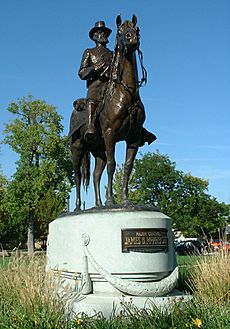
Many places were named in honor of General McPherson:
- Fort McPherson in Atlanta, Georgia, was named for him on February 20, 1866.
- McPherson Square in Washington, D.C., and its Metro rail station are named for him. A statue of McPherson on horseback stands in the center of the square.
- McPherson County, Kansas, and the town of McPherson, Kansas, are named in his honor. There is also a statue of him in the park across from the McPherson County Courthouse.
- McPherson Township, Blue Earth County, Minnesota, is also named for him.
- McPherson County, South Dakota, founded in 1873, was named in his honor.
- McPherson County, Nebraska, and Fort McPherson National Cemetery near Maxwell, Nebraska, were named for him. The cemetery was created on March 3, 1873.
- A monument marks the spot where McPherson died in East Atlanta. It is at the intersection of McPherson Avenue and Monument Avenue. McPherson Avenue in Atlanta was also named for him.
McPherson's portrait appeared on U.S. paper money in 1890 and 1891. These bills are called "treasury notes" or "coin notes." They are collected today because of their detailed engraving. The $2 McPherson note from 1890 is considered one of the "100 Greatest American Currency Notes."
The James B. McPherson Elementary School in Chicago, Illinois, was named for McPherson. In his hometown of Clyde, Ohio, the James B. McPherson Highway (US 20) was dedicated in his honor in 1941. The McPherson Middle School and McPherson Cemetery are also named for him. The cemetery was renamed McPherson Cemetery on December 15, 1868. A monument was built in his honor there on July 22, 1881. President Rutherford B. Hayes gave the dedication speech, and many Civil War officers, including General William Tecumseh Sherman, attended. His childhood home in Clyde, Ohio, is now a museum.
In Popular Culture
- The alternate history novel Never Call Retreat: Lee and Grant: The Final Victory by Newt Gingrich and William R. Forstchen features McPherson as a main character.
- In another alternate history book, If the South Had Won the Civil War by MacKinlay Kantor, McPherson survives. He becomes President of the United States in the 1880s and works to bring the country back together.
- McPherson and his hat are important in the book Map of Thieves by Michael Karpovage.
- The 1939 film Union Pacific shows a fictional steam locomotive named after McPherson.
See also
 In Spanish: James B. McPherson para niños
In Spanish: James B. McPherson para niños
- List of American Civil War generals (Union)
- Fort Date Creek


